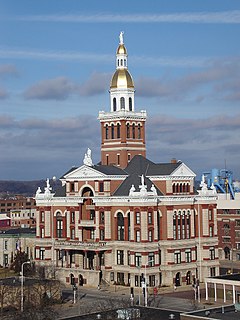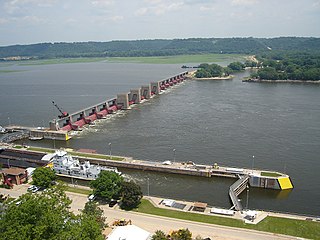
Des Moines County is a county located in the U.S. state of Iowa. As of the 2010 census, the population was 40,325. The county seat is Burlington. It is one of Iowa's two original counties along with Dubuque County; both were organized by the Michigan Territorial legislature in 1834.

Balltown is a city in Dubuque County, Iowa, United States. It is part of the Dubuque, Iowa Metropolitan Statistical Area. The population was 68 at the 2010 census, down from 73 at the 2000 census. Balltown is home to Breitbach's Country Dining, Iowa's oldest restaurant and bar, which was founded in 1852 and twice rebuilt by the community, following its destruction by fire in 2007 and 2008.
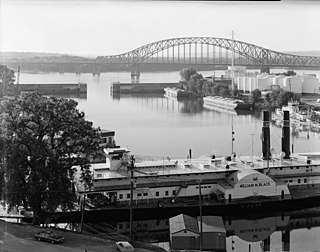
The Julien Dubuque Bridge crosses the Mississippi River. It joins the cities of Dubuque, Iowa, and East Dubuque, Illinois. The bridge is part of U.S. Route 20 route. It is one of two automobile bridges over the Mississippi in the area, and is listed in the National Register of Historic Places.
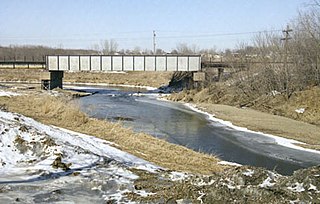
The Maquoketa River is a tributary of the Mississippi River, approximately 150 miles (240 km) long, in northeastern Iowa in the United States. Its watershed covers 1,694 square miles (4,387 km2) within a rural region of rolling hills and farmland southwest of Dubuque. It is not to be confused with the Little Maquoketa River, another distinct direct tributary of the Upper Mississippi River meeting the Big River north of Dubuque. The river and its tributaries mark the border of the Driftless Area of Iowa, with the areas east of it not having been covered by ice during the last ice age. Its name derives from Maquaw-Autaw, which means "Bear River" in Meskwaki.

The Mathias Ham House is a 19th-century house in Dubuque, Iowa that is on the National Register of Historic Places. It is located at the intersection of Shiras and Lincoln Avenues, near the entrances to Eagle Point Park and Riverview Park.

The United States Army Corps of Engineers Mississippi Valley Division (MVD) is responsible for the Corps water resources programs within 370,000-square-miles of the Mississippi River Valley, as well as the watershed portions of the Red River of the North that are within the United States. It excludes the entire watersheds of the Missouri River and Ohio River, and portions of the Arkansas River and the Red River of the South, but otherwise encompasses the entire Mississippi River from Lake Itasca, Minnesota, to the Gulf of Mexico. The district includes all or parts of 13 states: Arkansas, Illinois, Iowa, Kentucky, Louisiana, Michigan, Minnesota, Mississippi, Missouri, North Dakota, Tennessee, Wisconsin, and South Dakota.

The Upper Mississippi River National Wildlife and Fish Refuge is a 240,000-acre (970 km2), 261-mile long (420 km) National Wildlife Refuge located in and along the Upper Mississippi River. It runs from Wabasha, Minnesota in the north to Rock Island, Illinois in the south.

The Upper Mississippi River is the portion of the Mississippi River upstream of Cairo, Illinois, United States. From the headwaters at Lake Itasca, Minnesota, the river flows approximately 2000 kilometers (1250 mi) to Cairo, where it is joined by the Ohio River to form the Lower Mississippi River.
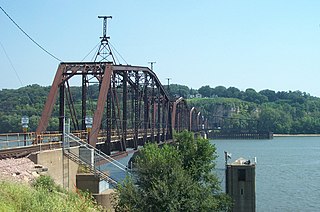
The Dubuque Rail Bridge carries a single rail line across the Mississippi River between Dubuque, Iowa, and East Dubuque, Illinois, near river mile 580.

Melvin Price Locks and Dam is a dam and two locks at river mile 200.78 on the Upper Mississippi River, about 17 miles (27 km) north of Saint Louis, Missouri. The collocated National Great Rivers Museum, at 1 Lock and Dam Way, East Alton, Illinois, explains the structure and its engineering.

Catfish Creek is a 21.2-mile-long (34.1 km) tributary of the upper Mississippi River in northeastern Iowa. It rises southwest of Dubuque, just southeast of Peosta. The Middle Fork rises west of Dubuque and flows under and then parallel to U.S. Route 20; the former Illinois Central Railroad, now the Chicago Central and Pacific Railroad has its mainline in it. The remaining forks of the creek are all south of U.S. Route 52. Swiss Valley Park, maintained by Dubuque County, is along the main fork of the creek, which is a designated trout stream through the park. In recent years, people have been trying to stop the erosion in this relatively flat way out of the Gorge of the Upper Mississippi. The North Fork of the creek has been proposed for a trail/park.
U.S. Highway 52 is a 166-mile-long (267 km) United States highway in northeast Iowa. The route begins at the Dale Gardner Veterans Memorial Bridge over the Mississippi River between Sabula and Savanna, Illinois. From Sabula, it heads north along the Mississippi towards Bellevue and Dubuque. At Dubuque, US 52 briefly shares an expressway with U.S. Route 61 and U.S. Route 151.

Sny Magill Creek is a minor tributary of the Upper Mississippi River, rising in central Clayton County, Iowa and flowing to the Upper Mississippi River approximately 2 miles north of Clayton, Iowa. It has a drainage of 22,780 acres (92.2 km2). It is regarded as one of the best trout streams in Iowa. The majority of this forested basin is incorporated into the Sny Magill-North Cedar Creek Wildlife Management Area.
Nine Mile Island may refer to:
U.S. Highway 67 (US 67) is a U.S. Highway in extreme eastern Iowa. The route begins in Davenport at the Rock Island Centennial Bridge where it crosses the Mississippi River and ends at an intersection with US 52 and Iowa Highway 64 (Iowa 64) west of Sabula. It passes through Bettendorf, Le Claire, and Clinton. Except for Folletts, every community which US 67 enters sits along the Mississippi River. As such, the entire route is part of the Great River Road, an All-American Road.

